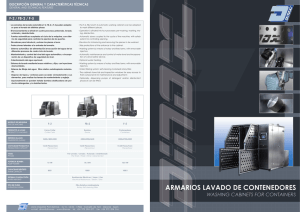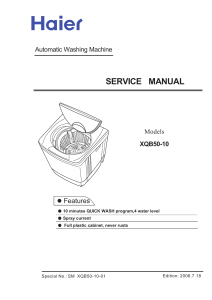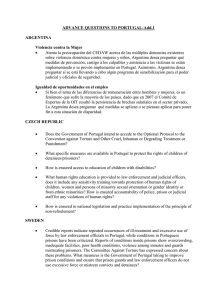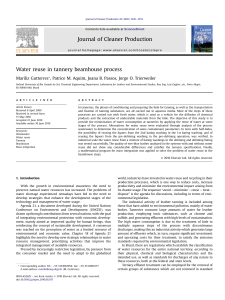Monitoring the washing machines market in Europe
Anuncio
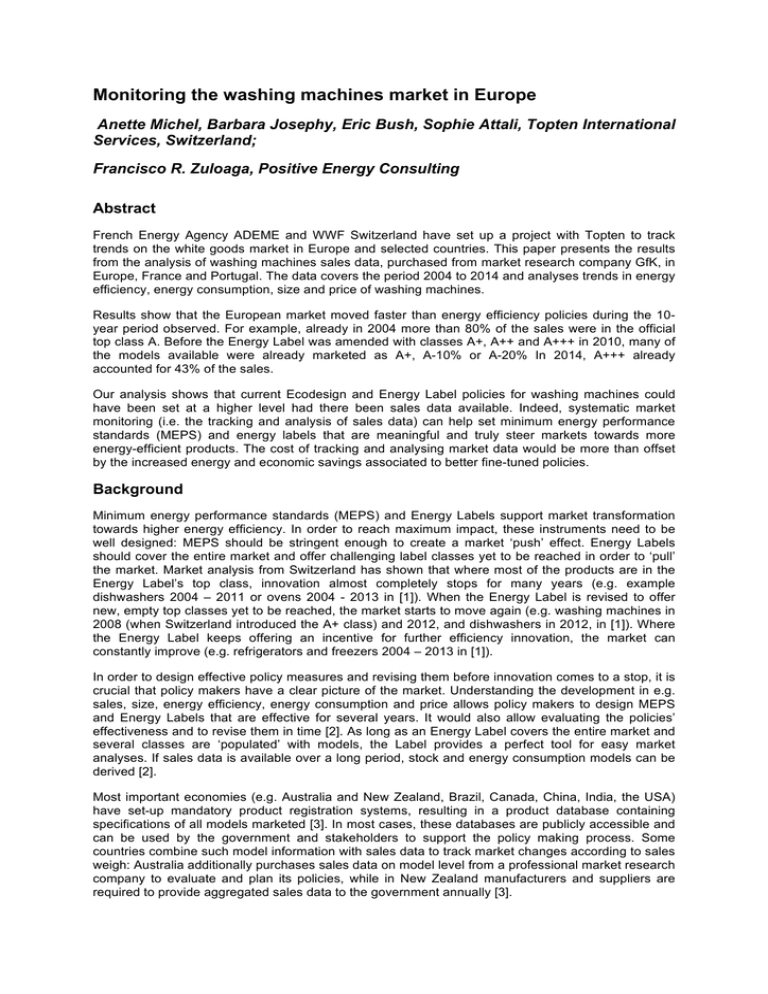
Monitoring the washing machines market in Europe
Anette Michel, Barbara Josephy, Eric Bush, Sophie Attali, Topten International
Services, Switzerland;
Francisco R. Zuloaga, Positive Energy Consulting
Abstract
French Energy Agency ADEME and WWF Switzerland have set up a project with Topten to track
trends on the white goods market in Europe and selected countries. This paper presents the results
from the analysis of washing machines sales data, purchased from market research company GfK, in
Europe, France and Portugal. The data covers the period 2004 to 2014 and analyses trends in energy
efficiency, energy consumption, size and price of washing machines.
Results show that the European market moved faster than energy efficiency policies during the 10year period observed. For example, already in 2004 more than 80% of the sales were in the official
top class A. Before the Energy Label was amended with classes A+, A++ and A+++ in 2010, many of
the models available were already marketed as A+, A-10% or A-20% In 2014, A+++ already
accounted for 43% of the sales.
Our analysis shows that current Ecodesign and Energy Label policies for washing machines could
have been set at a higher level had there been sales data available. Indeed, systematic market
monitoring (i.e. the tracking and analysis of sales data) can help set minimum energy performance
standards (MEPS) and energy labels that are meaningful and truly steer markets towards more
energy-efficient products. The cost of tracking and analysing market data would be more than offset
by the increased energy and economic savings associated to better fine-tuned policies.
Background
Minimum energy performance standards (MEPS) and Energy Labels support market transformation
towards higher energy efficiency. In order to reach maximum impact, these instruments need to be
well designed: MEPS should be stringent enough to create a market ‘push’ effect. Energy Labels
should cover the entire market and offer challenging label classes yet to be reached in order to ‘pull’
the market. Market analysis from Switzerland has shown that where most of the products are in the
Energy Label’s top class, innovation almost completely stops for many years (e.g. example
dishwashers 2004 – 2011 or ovens 2004 - 2013 in [1]). When the Energy Label is revised to offer
new, empty top classes yet to be reached, the market starts to move again (e.g. washing machines in
2008 (when Switzerland introduced the A+ class) and 2012, and dishwashers in 2012, in [1]). Where
the Energy Label keeps offering an incentive for further efficiency innovation, the market can
constantly improve (e.g. refrigerators and freezers 2004 – 2013 in [1]).
In order to design effective policy measures and revising them before innovation comes to a stop, it is
crucial that policy makers have a clear picture of the market. Understanding the development in e.g.
sales, size, energy efficiency, energy consumption and price allows policy makers to design MEPS
and Energy Labels that are effective for several years. It would also allow evaluating the policies’
effectiveness and to revise them in time [2]. As long as an Energy Label covers the entire market and
several classes are ‘populated’ with models, the Label provides a perfect tool for easy market
analyses. If sales data is available over a long period, stock and energy consumption models can be
derived [2].
Most important economies (e.g. Australia and New Zealand, Brazil, Canada, China, India, the USA)
have set-up mandatory product registration systems, resulting in a product database containing
specifications of all models marketed [3]. In most cases, these databases are publicly accessible and
can be used by the government and stakeholders to support the policy making process. Some
countries combine such model information with sales data to track market changes according to sales
weigh: Australia additionally purchases sales data on model level from a professional market research
company to evaluate and plan its policies, while in New Zealand manufacturers and suppliers are
required to provide aggregated sales data to the government annually [3].
Europe is lagging behind as it does not monitor markets of energy-using products (except for cars [3]
which indicates that it is possible in Europe), neither with a product registration system on model
basis, nor with sales data. Instead, whenever market data is needed for a preparatory study or impact
assessment, available data is collected in a time-consuming process by consultants. Usually this data
is provided by industry and is neither complete nor up-to-date, and cannot be compared over time and
between countries.
As a consequence of this lack of sound market data, product policy measures have been designed
not ambitiously enough and energy savings have been missed. Examples are the ban of refrigerators
classes B and C in 2010 (only 4% B and 0% C was left on the market in 2009, [11]), or the Energy
Labels for washing machines and dishwashers, with the new top class A+++ already populated after a
short time.
Objectives
The aim of this paper is to demonstrate the value of systematic market monitoring based on sound
sales data for washing machines. It complements other market monitoring reports such as the ones
on TVs [5], refrigerators [6], tumble driers [7] and the ones on household appliances from Switzerland
[1]. At the same time the data presented here supports the on-going revision of the washing machines
Ecodesign and Energy Labelling regulations [8, 9]. With national sales data from France and Portugal
for the 2004-2014 period, these countries can learn how national and European energy efficiency
policies and campaigns have impacted the appliances markets. This data also provides a solid basis
for these countries’ input into the Energy Label and Ecodesign revision process, as well as for
defining national strategies and campaigns to support the market transformation towards higher
energy efficiency.
Washing machines: Regulatory context
The first A to G EU Energy Label for washing machines was introduced in 1995 [10]. The Label was
based on a kWh/kg capacity efficiency definition, with 0.19 kWh/kg being the threshold of class A. The
energy consumption was defined based on a full load test at 60°C. In 2010, the Energy Label was
amended with classes A+ to A+++ [9]. At the same time, the efficiency definition was changed: the
Label classes are now based on an Energy Efficiency Index (EEI), the calculation of which is based
on annual energy consumption including low power modes and does also consider tests at 40°C and
with part load, additionally to the full load 60°C programme. The measurement standard was
amended to include these wash cycles, but also additional features were changed (e.g. different
detergent and type of soil). As a result, declarations before and after 2011 have to be compared very
cautiously. The new Label was compulsory from December 2011, while both Energy Label versions
could be used in the period from December 2010.
From the same date, the Ecodesign regulation applied, banning washing machine models not
reaching efficiency class A from the market [8]. Other requirements concerned washing efficiency
(min. former class A) and maximum water consumption. In December 2013 this MEPS level was lifted
to class A+ efficiency. Since then, all washing machine models must offer a 20°C programme.
Before the new Label officially introduced the ‘plus’-classes, manufacturers had already marketed
their machines that were exceeding class A efficiency as ‘A-10%’ or ‘A-20%’. Based on a voluntary
agreement between the Commission and CECED, some manufacturers officially labelled these
products as ‘A+’ before December 2010.
The Ecodesign and Energy Labelling regulations are both being revised at the moment. A preparatory
1
study has been launched which will make suggestions for new Label and Ecodesign requirements .
New measures are expected to be implemented in 2016.
Data and Methodology
2
Thanks to funds from ADEME (Agence de l’Environnement et de la Maîtrise de l’Energie), the Topten
study team could purchase sales data of washing machines for the EU, France and Portugal from
1
http://susproc.jrc.ec.europa.eu/Washing_machines_and_washer_dryers/index.html
2
3
GfK, a professional market analysis company present around the world . In Europe, GfK covers
around 90% of the refrigerator market, and all 28 Member States.. Sales data plus many product
characteristics are obtained from retailers.
GfK provided washing machines sales data including information regarding energy classes and
average size, energy and water consumption and price, covering years 2004 to 2014. This data was
4
obtained for France, Portugal, as well as for an aggregation of 21 EU Member States . All information
about specifications is according to the declaration on the Energy Label, with a few exceptions that
are explained below (A+ and A++ classes and energy and water consumption before 2011). Sales
data from Switzerland [1] is published annually and is also used here for comparison reasons.
Similar data was purchased for refrigerators and tumble driers. This is also presented at the EEDAL
conference 2015 (papers No. 50 [6] and 58 [7]). Further results about washing machines, refrigerators
and tumble driers will also be published on topten.eu [11] in May 2015.
Results and Interpretation
Sales numbers increased from 13.5 million to 15.1 million units from 2004 to 2007 in the EU-21
considered here, then fluctuated around 15 million units per year. In 2014, 15.2 million washing
machine units were sold. Sales in France show a similar pattern, stabilizing after 2010. In 2014, 2.38
million units were sold in France. In Portugal sales numbers climbed until 2011, then declined in 2011
and 2012. In 2014 sales were back at the 2009 level, at 284’000 units. (See also [11].)
!"#$%&'(%)'*$'+,--%-$./$0,-1()2$3,'1()%$-,+%-$
&**"#
+"#
%"#
&,"#
,*"#
!*"#
%+"#
'+"#
$!"#
!"#
&%"# &$"# %*"#
&*"#
)*"#
(&"#
!)"#
*"#
!"#
!"#
$"#
-..#
%%"#
%&"#
)*"#
$$"#
'+"#
'!"#
$("#
'&"#
%)"#
'"#
%"#
%"#
&"#
-.#
-#
%*"#
&&"#
-...#
'!"#
)("#
$'"#
&+"#
$,"# %+"#
(%"#
$*"#
'&"#
&"#
&"#
&&"#
)"#
%**$# %**)# %**!# %**(# %**,# %**+# %*&*# %*&&# %*&%# %*&'# %*&$#
/#
0#
12324#567#
5829:4#
;<93=>?=@#
Fig. 1: The most sold efficiency class has improved from A to A+++ in ten years
2
3
4
www.ademe.fr/
www.gfk.com
EU-28 without Bulgaria, Luxembourg, Estonia, Latvia, Lithuania, Malta and Cyprus.
3
Classes A+, A++ and A+++ were only ‘official’ starting in 2011: before 2011, GfK categorized as A+
whatever was declared as ‘A-10%’ (or A+), and ‘A-20%’ as A++. Sales share of these classes before
2011 has to be read with caution.
The efficiency development of washing machines happened much faster than expected by the
Commission. Already in 2004 the Energy Label was out-dated, with more than 80% of the sales in the
official top class A. By 2010, when in December the new Energy Labelling regulation entered into
force, 60% of the sales exceeded the class A threshold by 10% or more. There is an increase in class
A sales share from 2010 to 2011 – most likely due to the change of Label classification and test
measurements that happened at the same time. Still, already 14% of the sales were in the new top
class A+++ in 2011, the transition year of the new Label. Tier 1 of the Ecodesign regulation, banning
class B and less efficient from December 2011, was obsolete from its entry into force. These classes
had been virtually gone from the market several years earlier. Tier 2, banning class A from December
2013, was of minor effect – 11% of the sales still occurred in this class in 2013. In 2014, 43% of the
sales across the EU were in the top class A+++. Three years after the new Label became
compulsory, close to half of the sold washing machines were in the top class.
Figures 2 and 3 show that popularity of the efficiency classes can vary considerably on national
markets. The French market seems to have been less efficient than the EU average since 2005. In
2014, A++ had a higher sales share in France than in Europe (25% compared to 21%), but also A+
(39% vs 31%), and A+++ made up for only 31% of French sales compared to 43% in Europe. In
Portugal on the other hand the sales share of A+++ is already close to 50%, while yet in 2004 the sold
washing machines were clearly less efficient than in the average of the EU. The high efficiency of the
Portuguese washing machines market might be linked to the popularity of large washing machines
[11] (large machines tend to reach higher efficiency levels, see fig. 8). Even higher A+++ sales shares
can be found on the Swiss graph in [1]: 56% in 2012 and 61% in 2013.
These results imply that classes A+ to A+++ were introduced too late, and that class thresholds were
not defined ambitiously and wide enough. Indeed with 13% (A+) and 12% (A++, A+++) the relative
efficiency improvements between the classes are smaller than in other Labels (e.g. refrigerators &
freezers: A++ 21%, A+++ 33%; TVs: A+ 23%, A++ 30%), and actually only slightly larger than the
measurement tolerance of 10% (on energy consumption). The current revision of the Label is
overdue. A new Label will not be in place before 2017, until then manufacturers have no possibility to
market energy efficient innovations. However, these are already on the market: the best washing
machine model is exceeding the A+++ threshold by more than 50% (V-Zug Adora SLQ-WP with
integrated heat pump; EEI= 22.8, 8kg. Source: www.topten.eu).
!"#$%&'(&)%*&$%+(%,#--&-(./(0#-1*$2(3#%1*$&(-#,&-(
&''"#
+"#
&"#
&,"#
%&"#
+'"#
('"#
!)"#
%+"#
&"#
)"#
!"#
("#
&'"#
)$"#
)("#
)+"#
(!"#
()"#
(&"#
$$"#
-...#
-..#
%$"#
-.#
-#
)+"#
$*"#
%'"#
'"#
)&"#
%,"#
),"#
!)"#
&'"#
%&"#
%&"#
%$"#
!)"#
,'"#
&'"#
/#
)*"#
0#
)$"#
!"#
("#
$"#
%'',#
%''$#
&("#
)"#
%"#
)"#
%"#
%''(#
%''!#
%''+#
%''*#
%'&'#
%'&&#
%'&%#
%'&)#
1#
$"#
%'&,#
12324#567#
5829:4#
;<93=>?=@#
Fig. 2: In France, A+ was the most important class regarding sales in 2014
4
!"#$%&'()*+,-.+/-0*-('11+1*"2*3'14./&*5'-4./+*
1'(+1*
!,,#$
)#$
!#$
!"#$
'!#$
&,#$
+'#$
+#$
('#$
""#$
),#$
*#$
!+#$
!'#$
!&#$
'*#$
!+#$
(!#$
"(#$
(+#$
(%#$
-...$
')#$
+,#$
-..$
'%#$
-.$
")#$
(,#$
")#$
!&#$
',#$
"'#$
!%#$
!"#$ !!#$
,#$
(*#$
!'#$
%#$
&#$
!#$
''#$
+%#$
+)#$
(+#$ ("#$
!&#$
'#$
!#$
%#$
-$
/$
'+#$
%#$
',,($ ',,"$ ',,)$ ',,%$ ',,&$ ',,*$ ',!,$ ',!!$ ',!'$ ',!+$ ',!($
0$
12324$567$
5829:4$
;<93=>?=@$
Fig. 3: In Portugal, A+++ already accounted for 47% of the sales in 2014
*+&(',&)&-&(,%)./-01234/-)/5)6'0#7-,)2'.#7-&)
0'8&0)9!"#$%&'(:)
%))$
!"#$%&'()
!&)$
!))$
!+!$
!"($ !"'$ !%*$ !"!$ !"+$ !&%$ !%*$
!!)$
!)&$
'*#$
!!*$
!!*$
!!&$
!!)$ !'"$ !'%$ !!)$
!'+$
!'%$ !)#$
'*!$
'&)$
!"#$ !%!$
!!#$ !!"$ !!#$ !!#$ !!&$ !'($
!)&$ '*"$
'))$
'+&$
,-$
./0123$
45/67809$
&)$
)$
!))"$ !))&$ !))#$ !))($ !))+$ !))*$ !)')$ !)''$ !)'!$ !)'%$ !)'"$
:060;$<=>?$</0@A;$B5@631C37$
Fig. 4: Average annual energy consumption of sold washing machines started to decline after
2010.
Before 2011/12 the energy consumption was declared in kWh/cycle. These values have been
multiplied by 220 by GfK. This is the number of annual cycles assumed for the declaration on the
2010 Energy Label which applied from December 2011. Since the new declaration also includes part
load, 40°C cycles and low-power modes consumption, the values are not 100% comparable. While
the exact values have to be read with caution, this chart can show trends before 2011 and after.
After a reduction from 2004 - 2006, average annual energy consumption of the sold washing
machines remained stable at around 226 kWh/year in the EU. Only in 2011, with the introduction of
the new Label, it started to go down. In France and Portugal, average energy consumption even
5
increased between 2006 and 2009 / 2007 and 2010, respectively, before also decreasing. Since no
change in declaration occurred, the trend to larger machines (shown in [11]) must have outweighed
increasing efficiency in this period. In 2014, average annual energy consumption of the sold washing
machines was 185 kWh per year in the EU-21, 192 kWh/year in France and 196 kWh/year in
Portugal.
The reduction in declared and calculated energy consumption between 2004 and 2014 is 25% at EU
level, 30% in Portugal and 13% in France. This is comparable with the reduction that happened in
refrigerators, as shown in [6]. In the case of refrigerators the energy declaration however remained
the same, while for washing machines the real reduction is not so clear because of the changing
declarations: the new declaration is no longer only based on full load 60°C washing cycles (three out
of seven), but includes also 60°C half load and 40°C half load cycles (each two out of seven), and the
measurement standard changed. These changes mean that there is now an incentive for
manufacturers to also optimise the energy consumption of the 40°C and part-load pogrammes.
However part of the lower energy consumption after 2011 might be due to the inclusion of these less
energy consuming programmes – while on the other hand newly also low-power modes were included
(which can represent up to 12 kWh/year [12]). Own calculations, based on the values recommended
by the Commission in 2009 for transitioning between the old and new methods [13] and values
5
published on www.topten.eu , imply that around 10% of the reduction in energy consumption might
have occurred due to different methods. Still, the average declared energy consumption has
continuously been reduced since 2011 - despite a strong trend to larger washing machines (fig. 5).
Clearly the tested programmes have indeed been optimized regarding energy efficiency.
It is surprising that in Portugal, where most energy efficient washing machines were sold, the average
energy consumption is highest. An explanation can be found in the comparable large capacities that
Portuguese buy: while across the EU in 2014 still 41% were 6kg and smaller machines (fig. 5), in
Portugal only 20% were small (we use the term‘small’ here for convenience reasons, even though 6
or even 5kg machines were the standard ten years ago), 44% were declared as 7kg machines and
28% as 8kg |11]. This situation shows that larger capacity can cancel or even outweight the savings of
better-rated machines – at least for a usage according to the Energy Label.
Effective energy consumption of course depends on the usage of the machines. According to a
6
product expert , Portuguese use their wasing machine often (more often than dishwashers) and wash
rather small loads. According to the expert, Portuguese consumers do not choose large washing
machines because they wash large loads, but because nearly no small machines are offered on the
market.
5
The Commission recommended to assume that the energy consumption of a 60°C half load programme is 0.8 times that of a
60°C full load, and the consumption of a 40°C half load 0.64 that of a 60°C full load programme. Furthermore, 12.5 kWh per
year were added for the Standby and Off modes. Data from Topten.eu shows that these assumption are still fairly correct (in
September 2014, just after the product lists were updated), but variations are large. The consumption by low power modes has
not been compared.
6
Oral information from Laura Carvalho, Quercus / Topten Portugal ( www.topten.pt/) in March 2015
6
!"#$%&'&()*+,$-./0$12$3&,4)5/$6&(4)5+$,&7+,$
&,,#$
+#$
&#$
)#$
)#$
%#$
',#$
%,#$
(,#$
!"#$ !%#$
!&#$
&#$
&#$ +#$
*#$ &#$
"#$ '#$ !#$ )#$ *#$ *#$ %#$
&&#$ &)#$
&&#$
&%#$ &!#$
&(#$
&'#$
+)#$
+"#$
),#$
)+#$
)*#$
'(#$
-$'./$
'./$
"!#$ ")#$
%%#$
"./$
*!#$
+,#$
*)#$
(%#$
0$%./$
(&#$
,#$
+,,($ +,,*$ +,,%$ +,,"$ +,,'$ +,,!$ +,&,$ +,&&$ +,&+$ +,&)$ +,&($
12324$567$
5829:4$
;<93=>?=@$
Fig. 5: There is a strong trend to larger capacities.
Ten years ago nearly all washing machines were for 6 kg of laundry and less, then the strong trend to
larger capacities started. In 2014, more than half of all washing machines sold were designed for
washing 7 kg laundry and more. It seems that the trend to large washing machines is rather coming
from the changed market offer than from consumer demand. It is questionable if washing habits are
changing so suddenly to washing larger loads, especially since the average household size is
declining (Eurostat). The Energy Label might be at least partly responsible, since it was easier for
large machines to reach good efficiency levels. With the new EEI system and the inclusion of part
load washing the effect is less direct than it was in the old Label, but the trend has been continuing.
Even if they are A+++, oversized washing machines do not contribute to energy saving. Instead,
energy and water will be wasted if most wash cycles run with low part loads (e.g. 2-3kg in 8kg
machines).
*+,)'-&('.&)&/&(.%)01/234561/)17)8'2#9/.)4'0#9/&)
2':&2)9/);<=>))
')(#
!"#$%&'()
'((#
'''#
!$%#
!$&#
*++#
*+#
!"!#
!)(#
!((#
)(#
(#
*+++#
*#
,-.-/#0123#04-56/#785.9:;9<#
Fig. 7: Energy consumption differences between efficiency classes are not so large
7
!"#$%&'&%()*+$,-$.&+/(01$2&%/(0*$+&3*+4$5678$
!**#$
"*#$
"#$
!#$
)#$
!!#$
'#$
"#$
((#$
!&#$
%%#$
)*#$
'*#$
!*#$
-"./$
'!#$
'(#$
(*#$
"./$
&!#$
&!#$
&./$
01)./$
%&#$
!"#$
*#$
+,,,$
+,,$
+,$
+$
23435$6789$
6:3;<5$
=>;4?@A?B$
Fig. 8: Efficient washing machines are large washing machines
Figures 7 and 8 show energy consumption and size differences between efficiency classes. The
reduction in energy consumption between the classes is small to nearly non-existent: the average
declared energy consumption of all class A+ and A++ washing machines that were sold in 2014 is
virtually the same. There are two reasons for the small differences in energy consumption:
First,.washing machines sold in the two top efficiency classes have clearly larger capacities than A+
and A models. Efficient washing machines are larger washing machines – the larger load leads to a
relative increase in consumption and weakens the effect of higher efficiency. Second: the efficiency
steps between the classes are not large. Our calculations show that a difference of four classes (A to
A+++) results in a reduction in energy consumption of 23% only. In the case of refrigerators for
example, this reduction is achieved with a step of one single class [6].
While these declared energy consumption values are valuable for comparing models with each other,
they however bear little evidence of how much energy washing machines are consuming in reality,
when users choose programmes different from the test programmes or fill their 8-kg-machines with
2kg only. Larger washing machines certainly bear the risk of wasting more energy than smaller ones.
8
%&'()*'$+(,-'$./$0)12,3*$4)-2,3'$1)5'1$$
#(($
!#($
!#)$ !#"$
!"&$ !"'$ !%"$
!(($
")%$
!"#$
"+"$ "&!$ "*+$
!(($ !"#$ !%&$ !%%$ !%%$
"*#$
!'%$ !(&$ !'($ !(($ !(!$ "))$ "))$
"#($
"(($
,-$
%#($
./0123$
%(($
'#($
"**$ "##$ "#!$ "!'$ "#($ "#($ "*'$ "!*$ "!!$ "#($ "!#$
45/67809$
'(($
#($
($
%((!$ %((#$ %((*$ %((&$ %((+$ %(()$ %('($ %(''$ %('%$ %('"$ %('!$
:060;$<=>?$</0@A;$B5@631C37$
Fig. 6: Average real prices have declined, despite higher efficiency and larger capacities.
Across the EU-21, average washing machine real prices have declined by 8% from 2004 to 2014 –
despite higher efficiency and larger capacities. In France, the reduction in price was even 20%. In
Portugal, where the sold washing machines are larger and more efficient, average prices are lower.
The price reduction in ten years was 6% in Portugal. Since 2009, French and Portuguese average
prices have been increasingly below the EU average. In 2014, A+++ washing machines cost on
average 69% more than A+ washing machines in the EU [11]. Since more efficient washing machines
are also larger, this price premium is linked to both energy efficiency and size.
Conclusions
The first glance on figures 1 to 3 shows a successful efficiency improvement on the washing
machines market between 2004 and 2014. Some considerations and more detailed analysis however
show some problems and raise questions on the real success.
•
Between 2004 and 2011, manufacturers had no official possibility to market energy efficient
innovations. More than half of the washing machines that were sold in 2009 and 2010 were
declared as exceeding the top class A by more than 10%.
•
Soon the situation will be the same again: already 43% of the sales were in the top class
A+++. Information on www.topten.eu shows that in July 2015, the best washing machine
model is exceeding the A+++ threshold by more than 50% (V-Zug Adora SLQ-WP with
integrated heat pump. EEI= 22.8).
•
The 2010 Energy Label has not stopped the trend to larger washing machines. It still seems
to offer an incentive for higher capacities, because larger washing machines can still reach
good efficiency levels easier than smaller machines. Combined with small efficiency steps
between the classes, this results in doubtful energy savings. This is underlined by the fact that
the average energy consumption of the sales in Portugal is higher than in France and the EU,
even though Portuguese buy more energy efficient washing machines.
Recommendations: Energy Label revision
The current Energy Label has been implemented too late, and the added classes were not ambitious
enough. The ongoing revision must avoid this mistake and define a Label with classes that can
encourage the development of more energy-efficient washing machines for several years into the
9
future. In addition, the Label should be re-scaled to the original A-G scheme, which has shown to be
most effective in many studies (e.g. [14|), with the top classes reserved for future innovations.
Furthermore the efficiency classes, the most important communicative aspect of the Energy Label,
must also be the most important aspect defining the energy consumption – more important than
capacity. The new energy label for washing machines should stop encouraging larger machines’.
Both can be achieved with a progressive reference line (SAEc): the requirements for reaching a
specific efficiency level should be higher for larger machines. At the same time it is recommended to
include an ‘average’ or even ‘small’ load test cycle (3kg or less) into the EEI and energy consumption
calculation (see also [15]).
Systematic market monitoring
Through systematic market monitoring of energy-using products, Europe has the opportunity to set
new MEPS and labels that truly encourage a trend towards more energy-efficient products. Such a
monitoring system would be inexpensive to implement when compared to the vast energy and
economic savings that it will enable. It is hard to understand that Europe renounces on the huge
benefits of market monitoring: professional market research companies have the data and it does not
cost a lot. Analyzing the market on a systematic basis with sound data would be more cost-effective
than today’s rather chaotic practice. Even if market monitoring on the longer term was based on a
mandatory product registration system and on model data, monitoring based on sales data can start
now.
References
[1]
S.A.F.E. and FEA: Swiss appliances sales development 2004 – 2013. July 2014.
http://www.topten.eu/uploads/File/FEA-Geraetestatistik-2004-2013-EN.pdf
[2]
Attali, Bush, et al.: Can Europe continue deciding on product policies (MEPS; labels, etc.)
without monitoring the market? Presented at the eceee summer studies in France, June 2013.
[3]
Michel, Attali, Bush, Jones: Why Europe should introduce mandatory product registration and a
public database for energy related products. Discussion paper. November 2014.
www.topten.eu/uploads/File/Topten-discussion-paper-product-registrationdatabase_Nov_14.pdf
[4]
CSES, 2012: Evaluation of the Ecodesign Directive (2009/125/EC), Final Report.
[5]
Michel, Attali, Bush: European TV market 2007 – 2013. Second report, complemented with
2013 sales data. Topten International Services, July 2014.
[6]
Michel, Harrington et al.: Household refrigerators: Monitoring efficiency changes in Europe and
Australia over the last 10 years. Presented at EEDAL, August 2015.
[7]
Bush, Michel / Zuloaga, Granda, Wold: Heat Pump Tumble Driers: MEPS in Switzerland,
Market Development in Europe, Market Introduction in North America.
[8]
European Commission: Commission regulation No 1015/2010 with regard to Ecodesign
requirements for household washing machines
[9]
European Commission: Commission delegated regulation No 1061/2010 with regard to energy
labelling of household washing machines. September 2010.
[10]
European Commission: Commission Directive 95/12/EC with regard to energy labelling of
household washing machines. May 1995.
[11]
Anette Michel, Sophie Attali, Eric Bush: Energy efficiency of White Goods in Europe: monitoring
the
market
with
sales
data.
3.
June
2015.
www.topten.eu/uploads/File/WhiteGoods_in_Europe_June15.pdf
10
[12|
Van Holsteijn en Kemna: ‘Omnibus’ review study on cold appliances, washing machines,
dishwashers, washer-driers, lighting, set-top Boxes and pumps. Final report, March 2014.
[13]
EuropeanCommission. Draft COMMISSION REGULATION (EC) implementing Directive
2005/32/EC of the European Parliament and of the Council with regard to ecodesign
requirements for household washing machines. Version of 18 March 2009.
[14]
Molenbroek, Waide, Attali et al.: Evaluation of the Energy Labelling Directive and specific
aspects of the Ecodesign Directive. Final technical Report. Ecofys, June 2014.
[15]
Topten.eu: Washing machines & combined washer-driers: Policy recommendations. February
2015. http://www.topten.eu/uploads/File/Topten_recommendations_Washing_machines.pdf
11
